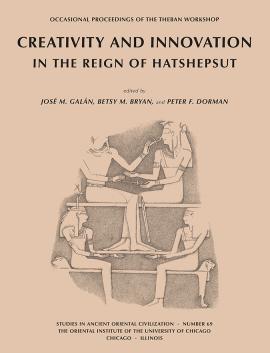SAOC 69. Innovation and Creativity in the Reign of Hatshepsut. Edited by José M. Galán, Betsy M. Bryan, and Peter F. Dorman. Studies in Ancient Oriental Civilization 69. Chicago: The Oriental Institute, 2014. Pp. lxx + 442; 284 figures, 6 tables. ISBN 987-1-61491-024-4. $64.95
The volume contains nineteen papers that present new perspectives on the reign of Hatshepsut and the early New Kingdom. Available in print and online.
1. Innovation at the Dawn of the New Kingdom. Peter F. Dorman, American University of Beirut
2. The Paradigms of Innovation and Their Application to the Early New Kingdom of Egypt. Eberhard Dziobek, Heidelberg and Leverkusen
3. Worldview and Royal Discourse in the Time of Hatshepsut. Susanne Bickel, University of Basel
4. Hatshepsut at Karnak: A Woman under God’s Commands. Luc Gabolde, Centre National de la Recherche Scientifique (UMR 5140)
5. How and Why Did Hatshepsut Invent the Image of Her Royal Power? Dimitri Laboury, FNRS-University of Liège
6. Hatshepsut and Cultic Revelries in the New Kingdom. Betsy M. Bryan, Johns Hopkins University
7. The Exceptional Creativity of Hatshepsut. Zbigniew E. Szafrański, University of Warsaw
8. The Foundation Deposits of Hatshepsut’s Mortuary Temple at Deir el-Bahari. Catharine H. Roehrig, Metropolitan Museum of Art, New York
9. Remarques sur l’architecture du Spéos Artémidos. Jean-Luc Chappaz, Museum for Art and History, Geneva
10. The Power of the Elite: The Officials of Hatshepsut’s Regency and Coregency. JJ Shirley, Journal of Egyptian History
11. The Inscribed Burial Chamber of Djehuty (TT 11). José M. Galán, Spanish National Research Council, Madrid
12. The Composition of the Opening of the Mouth in the Tomb-chapel of Djehuty (TT 11). Jose M. Serrano, University of Seville
13. Play and Display in Egyptian High Culture: The Cryptographic Texts of Djehuty (TT 11) and Their Sociocultural Contexts. Andrés Diego Espinel, Spanish National Research Council, Madrid
14. Unconventional Versions: The Theban Tomb of Puiemra, Second Prophet of Amun under Hatshepsut. Barbara Engelmann-von Carnap, University of Heidelberg
15. Mitanni Enslaved: Prisoners of War, Pride, and Productivity in a New Imperial Regime. Ellen Morris, Barnard College
16. A View from Elkab: The Tomb and Statues of Ahmose-Pennekhbet. W. V. Davies, British Museum, London
17. Overseers of Southern Foreign Lands and Thebes in the Reign of Hatshepsut. Tamás A. Bács, Eötvös Loránd University, Budapest
18. An Unusual Architecture of Hatshepsut in Nubia. Charles Bonnet, Académie des Inscriptions et Belles Lettres, Paris
19. The Part of Hatshepsut in Some Architectural Programs of the Early Eighteenth Dynasty. Dominique Valbelle, Université de Paris-Sorbonne, Paris IV/UMR 8167


